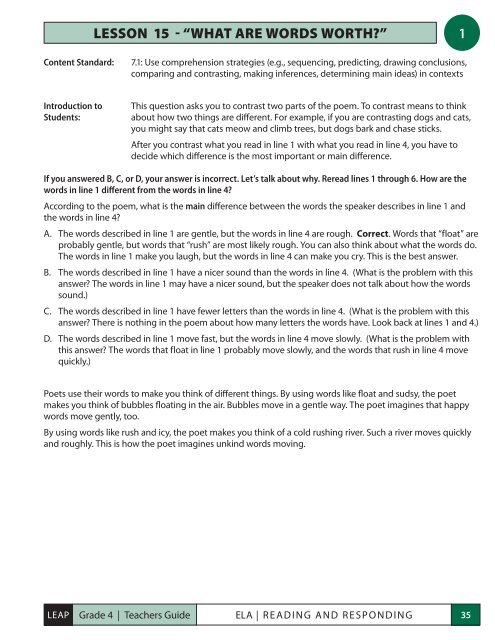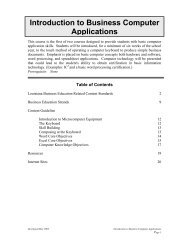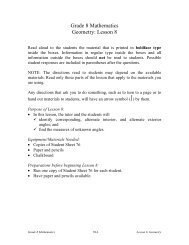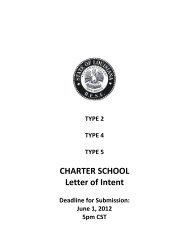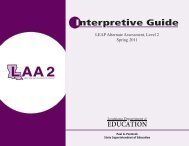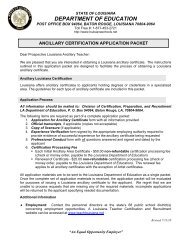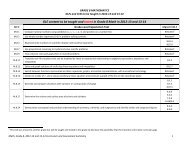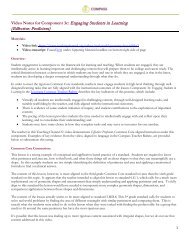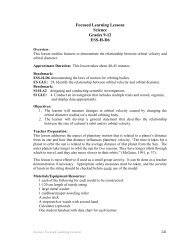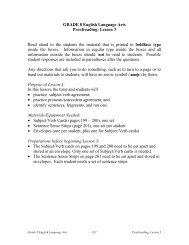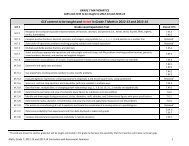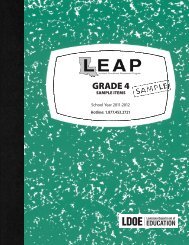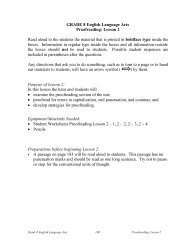Reading & Responding - Louisiana Department of Education
Reading & Responding - Louisiana Department of Education
Reading & Responding - Louisiana Department of Education
You also want an ePaper? Increase the reach of your titles
YUMPU automatically turns print PDFs into web optimized ePapers that Google loves.
LESSON 15 - “WHAT ARE WORDS WORTH?” 1Content Standard:7.1: Use comprehension strategies (e.g., sequencing, predicting, drawing conclusions,comparing and contrasting, making inferences, determining main ideas) in contextsIntroduction toStudents:This question asks you to contrast two parts <strong>of</strong> the poem. To contrast means to thinkabout how two things are different. For example, if you are contrasting dogs and cats,you might say that cats meow and climb trees, but dogs bark and chase sticks.After you contrast what you read in line 1 with what you read in line 4, you have todecide which difference is the most important or main difference.If you answered B, C, or D, your answer is incorrect. Let’s talk about why. Reread lines 1 through 6. How are thewords in line 1 different from the words in line 4?According to the poem, what is the main difference between the words the speaker describes in line 1 andthe words in line 4?A. The words described in line 1 are gentle, but the words in line 4 are rough. Correct. Words that “float” areprobably gentle, but words that “rush” are most likely rough. You can also think about what the words do.The words in line 1 make you laugh, but the words in line 4 can make you cry. This is the best answer.B. The words described in line 1 have a nicer sound than the words in line 4. (What is the problem with thisanswer? The words in line 1 may have a nicer sound, but the speaker does not talk about how the wordssound.)C. The words described in line 1 have fewer letters than the words in line 4. (What is the problem with thisanswer? There is nothing in the poem about how many letters the words have. Look back at lines 1 and 4.)D. The words described in line 1 move fast, but the words in line 4 move slowly. (What is the problem withthis answer? The words that float in line 1 probably move slowly, and the words that rush in line 4 movequickly.)Poets use their words to make you think <strong>of</strong> different things. By using words like float and sudsy, the poetmakes you think <strong>of</strong> bubbles floating in the air. Bubbles move in a gentle way. The poet imagines that happywords move gently, too.By using words like rush and icy, the poet makes you think <strong>of</strong> a cold rushing river. Such a river moves quicklyand roughly. This is how the poet imagines unkind words moving.LEAPGrade 4 | Teachers GuideELA | READING AND RESPONDING35


